- FLYNN
DRAIN BEND: seat faces SOUTH
- FRASER-SPENCE
PLAYGROUND VIEW: seat faces NORTH-EAST
- MOCK-TUDOR HOUSE SEAT: seat faces SOUTH-EAST
- NOTICE-BOX SEAT: Faces West
- AVERY-WOODGER SEAT: Faces WEST
- BELCONNEN VIEW SEAT: Faces SOUTH
- SNOW GUM SEAT. Faces SOUTH
- ABOVE MAGRATH SEAT: Faces NORTH-EAST
...........................................................................................
FLYNN DRAIN BEND: seat faces SOUTH
The 300-year old eucalypt where the Schwarz Pl. entry meets
the main gravel path is famous for Tawny Frogmouths having nested in its fork
for several springs. Sharing observations & photos of the family
transformed the Mt Rogers community into observant naturalists.
The drain channels rainwater from the reserve down towards
Ginninderra Creek through & under Flynn. There’s a damp patch in the grass
that dogs love to investigate. Peewees use the mud in spring to make
their nests.
The eucalypt species around the playground & others up
behind the seat were planted to restore the grazed land in the 70’s. Original
eucalypts might be 300–400 years old.
Some wattles were planted & others have regenerated.
Wattles benefit other plants by restoring nitrogen to the soil. At all stages
of their lives wattles, like shrubs, are essential habitat & sources of
food for small birds.
The gully off to the left is often good for bird-watching.
The steep track behind the No Motorbikes notice shows how
erosion occurs on people-made straight up-hill tracks. Gravity speeds up water
which gouges out soil loosened by many feet. Mt Rogers’ soil is thin &
often rocky. Deeper into the reserve areas of vegetation are freer of
introduced grasses & weeds. Lilies, other wildflowers, mosses, lichens and
fungi can be spectacular, in miniature, in good seasons.
…………………………………………………………………………………………
FRASER-SPENCE PLAYGROUND VIEW SEAT: Faces NORTH EAST
At a 5–6 way junction the Blue-metalled track leads up to
utilities near the 704 m Mt Rogers summit & right to the reservoirs.
16 cul-de-sacs give access to the reserve from the 4 suburbs & 6 locked
gates for the authorities’ vehicles. TAMS personnel are the area’s land
managers (TAMS is now called TCCS, i.e. Transport Canberra and City Services).
Apart from the gravel track circling the edge of the
vegetation there are numerous informal tracks going cross-country from the main
track. Kangaroos make their own pathways as they graze or move through the
woodland sections.
New kangaroos may be scared up to Mt Rogers via easements
through Flynn and Fraser.
To the right & on the mown zone there’s an old eucalypt
sprouting new vertical branches after it fell.
Behind to the left is an ancient
eucalypt that has a maze of branches & hollows. It’s probably been a vital
habitat tree for birds & arboreal mammals for more than 300 years.
It’s surrounded by the complexity and, some say, the
untidiness of the bush. Wattles, when dead, still provide shelter from
predators for small birds. Under their bark, as the whole tree decays, there’s
a diversity of borers, larvae & bugs that provide food for insectivorous
birds.
Some of the dead trees & fallen timber will become ash
in the next Hazard Reduction Burn with the ash returning nutrients to the soil
for other plants to utilise.
………………………………………………………………………………………
MOCK-TUDOR HOUSE SEAT: Faces SOUTH-EAST
CAREY
- HAMMETT SEAT: Faces SOUTH-EAST
The
easement between Hammett and Carey Places is a busy entry to Mt Rogers from
Spence. The Landcaring family now in the Tudor house have cut the Photinia
hedge right back. It won’t produce as many berries now. Photinia is now a
garden escapee & volunteers find its seedlings when removing weeds like
privet, cotoneaster & ivy. The opposite garden shows how to trim back weed
species whilst retaining the plants as a screen or hedge.
Closer
to the main track are a few Melaleucas. These tall shrubs were planted in the
1970s to revegetate what sheep had grazed.
Behind
the seat there are several steep tracks leading up to the 704m summit & its
360 degree views.
Most
of the trees along this edge of the hill were also planted or are the offspring
of planted eucalypts & wattles, including Cootamundra wattle.
The Mt
Rogers Landcare Group checks through the reserve regularly and removes privet,
cotoneaster, hawthorn, firethorn plants that grew from berries brought in by
birds.
To the
distant left, Crace is visible. Being a modern development there is little
space for trees or shrubs.
How
will the lack of greenery affect the residents?
Will
there be varied surfaces for walkers to use?
Will
the suburb be hotter & need more electricity to cool houses? Will there be
populations of the birds we enjoy?
………………………………………………………………………………………
NOTICE-BOX SEAT: Faces West
Views towards the distant Brindabella Ranges & north
towards the Wallaroo area in NSW are especially colourful at sunset. Moving
clouds indicate influential changes in the weather.
From the 1980s Dunlop was built into paddocks. It’s no
longer possible to see where Ginninderra Creek turns west towards its
confluence with the Murrumbidgee River.
From here we are able to appreciate the importance of green
spaces for connectivity as birds move to and from the ranges in spring and
autumn. Suburban trees play their part for migrating birds. Un-harvested fruit
is important for some species in summer.
Boulders provide wattles with a refuge from the mowers.
Behind the seat there’s a huge Apple Box (Eucalyptus bridgesiana). It’s surrounded by the
natural untidiness of the bush with grasses, wildflowers, shrubs and small
trees all contributing to the nutrient-rich leaf-litter of Mt Rogers’ grassy
woodland habitats. Beetles, termites, native cockroaches & moth larvae feed
on the litter releasing nutrients, regardless of leaves having phenols,
tannins, oils & toxic chemicals.
The track beside the gum tree shows the effect of rainwater
eroding the thin soils and exposing rocks and roots.
Simple run-offs now divert water into the bush to restore
the groundwater. Water rushing downhill reaches & erodes the main gravel
path, affecting all walkers when rocks are exposed.
……………………………………………………………………………………
AVERY-WOODGER SEAT: Faces WEST
The eucalypts here used to benefit from nitrogen from wattles
growing near them. Many wattles & shrubs in the Fire Abatement Zone have
been cleared to protect homes & infrastructure.
The bush to the right represents the species that comprise a
healthy Grassy Woodland ecosystem in the ACT region. There’s a mix of ancient
eucalypts & their younger offspring. There are wattles, Cassinias & other shrubs which
provide insect prey, nectar, seeds and shelter for a range of birds through the
seasons.
In spring there are species of wildflowers that bring
blushes of colour to the ground & leaf-litter.
These natives are testimony to the extraordinary tenacity of
some species & their seed dispersal methods. They’ve survived 4 decades of
being surrounded by very different garden habitats. Huge changes in soil
structure & fire regimes have altered soil chemistry & consistency.
Birds from the 80+ species on Mt Rogers’ bird species list,
including Superb Parrots, Common Bronzewing Pigeons, Butcherbirds, Honeyeaters
regularly visit this good quality, natural woodland remnant.
………………………………………………………………………………………
BELCONNEN VIEW SEAT: Faces SOUTH
With Black Mountain and Bruce Ridge in the distance this
might be a view to celebrate human achievement. The light towers for the AIS
are clearly visible as is Belconnen.
As suburban trees have grown taller the line of Ginninderra
Creek has become less obvious.
To the left the sprawl of suburbs over grazing land is seen.
The Natural Temperate Grasslands reserve to the north of the
Lawson development has the creek as its western boundary. The Ginninderra
Peppercress grows amongst the native grasses and wildflowers. It’s a small
plant only found on the site of the ex-transmission station. The rare Golden
Sun Moth is also found there. Both are species unique to Australia.
The Grasslands are protected but the land taken by the
development means less grazing-space for mobs of kangaroos.
Native Grassland habitats are as special in the ACT as
rainforests are in the tropics.
The eastern third of Mt Rogers was Hazard Reduction Burnt in
August 2011. The area was patch burnt with care being taken not to damage the
existing trees. Between the trees are quite extensive swathes of Weeping Grass
(Microlaena stipoides).
This native grass remains green during the summer as it prepares to flower. Mt Rogers’
small mob of kangaroos likes Microlaena.
Downhill from the main path the introduced grasses are mown
to reduce fire risk to homes and power-lines. Earthworks 45 years ago were
made to prevent water flowing downhill towards houses.
………………………………………………………………………………………
SNOW GUM SEAT. Faces SOUTH
This corner is named for the planted Snow Gums (Eucalyptus
pauciflora) clustered with Cassinia shrubs behind the seat. 6–7
Snow Gum clusters were planted in Mt Rogers’ 60 hectares, with other eucalypts
& native species, as the suburbs were built.
Hidden by the gums & shrubs are several large boulders.
There are native wildflowers and grasses here with rank introduced grasses from
the grazing days usually hiding a narrow track up to more boulders by the
Second Summit.
Mt Rogers’ boulders are of volcanic origin & were once
buried deep underground. More can be seen by taking the track to the left &
looking out from the 704 m summit.
In the distance, over Bainton Cres, are Mounts Majura &
Ainslie. Black Mountain & Mt Painter are backdrops to treed Belconnen
suburbs, Belconnen & Lake Ginninderra.
From the seat, the scale of the mowing maintenance task can
be appreciated. Wide expanses of grass need mowing or slashing between the
gravel path & residences to reduce likelihood of fire reaching houses &
infrastructure. Over 50 reserves need this mowing protection in the ACT.
Shrubs are not welcome in these Fire Abatement Zones.
The bush one mower-width ‘above’ the gravel path is retained
as wildlife habitat. Mt Rogers Landcare Group removes environmental weeds &
invasive grasses from amongst the native vegetation.
………………………………………………………………………………………
ABOVE MAGRATH SEAT: Faces NORTH-EAST
Beyond the Spence houses &
into the distance is open grazing-land in NSW. The ridgelines beyond Hall might
entice walkers to try the section of the Centennial Trail from Hall to One Tree
Hill. The view here doesn’t show how new Gungahlin suburbs continue to encroach
on the paddocks that surround some of the headwaters of Ginninderra Creek.
Rainwater draining off Mt Rogers has caused problems under
the four suburbs’ gardens when it reaches them underground rather than flowing
overland into the embanked drains as planned in the seventies.
The mown zone shows many that eucalypt saplings have grown
from epicormic buds aiming to become trees.
Behind the seat the soils may be thin and dry. Only native
grasses can survive. They grow in clumps with leaf-litter and bark from the
trees surrounding them. There are at least 15 different species of native
grasses on Mt Rogers. In the settlement days native grasses were despised
as being useless for European-style agriculture. Pasture improvement species
& the use of artificial fertilisers destroyed both the structure and
biological diversity of hectares of natural vegetation. Weeping Grass is green
through summer & is among those Australian grasses that are now considered
to be valuable & drought resistant.
Towards the summit the dried-off introduced grasses &
oats show their persistence through generations of seeds stored in the
reserve’s soils.
……………………………………………………………………………………
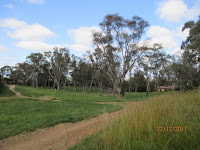
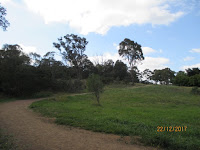










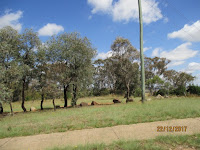



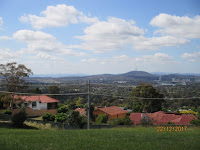




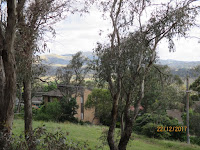

Loved finding these notes. ..though one was being ripped away by the wind.
ReplyDeleteMost informative blog. Thanks Photinia Super Hedge | Magnolia Port Wine
ReplyDeleteNotice are very good. Thanks. Bird of Paradise Plant | Strelitzia Reginae
ReplyDelete